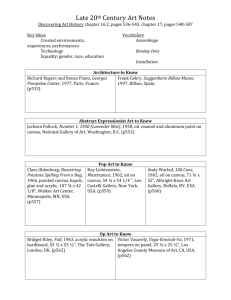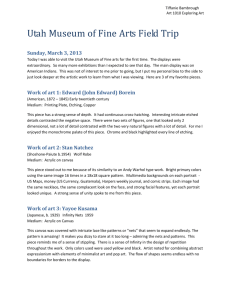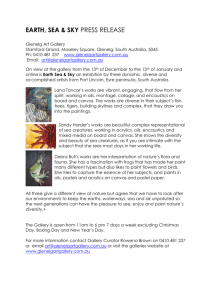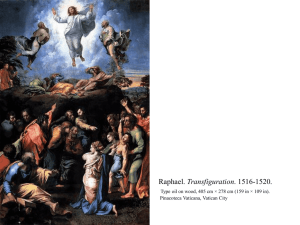John Kiki - Norfolk Museums Service
advertisement
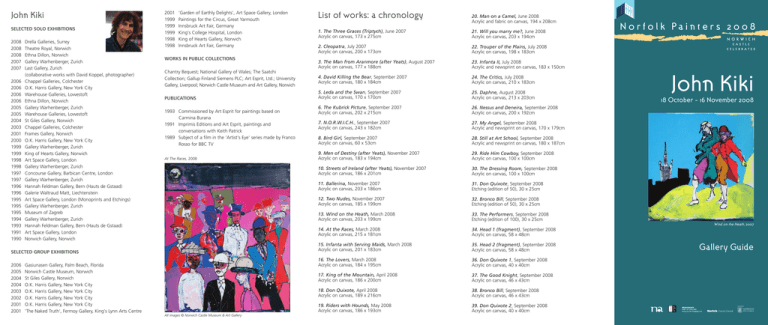
John Kiki SELECTED SOLO EXHIBITIONS 2008 2008 2008 2007 2007 2006 2006 2006 2006 2005 2005 2004 2003 2001 2000 1999 1999 1998 1998 1997 1997 1996 1996 1995 1995 1995 1994 1993 1991 1990 Drella Galleries, Surrey Theatre Royal, Norwich Ethna Dillon, Norwich Gallery Warhenberger, Zurich Last Gallery, Zurich (collaborative works with David Koppel, photographer) Chappel Galleries, Colchester O.K. Harris Gallery, New York City Warehouse Galleries, Lowestoft Ethna Dillon, Norwich Gallery Warhenberger, Zurich Warehouse Galleries, Lowestoft St Giles Gallery, Norwich Chappel Galleries, Colchester Frames Gallery, Norwich O.K. Harris Gallery, New York City Gallery Warhenberger, Zurich King of Hearts Gallery, Norwich Art Space Gallery, London Gallery Warhenberger, Zurich Concourse Gallery, Barbican Centre, London Gallery Warhenberger, Zurich Hannah Feldman Gallery, Bern (Hauts de Gstaad) Galerie Waltraud Matt, Liechtenstein Art Space Gallery, London (Monoprints and Etchings) Gallery Warhenberger, Zurich Museum of Zagreb Gallery Warhenberger, Zurich Hannah Feldman Gallery, Bern (Hauts de Gstaad) Art Space Gallery, London Norwich Gallery, Norwich 2001 1999 1999 1999 1998 1998 'Garden of Earthly Delights', Art Space Gallery, London Paintings for the Circus, Great Yarmouth Innsbruck Art Fair, Germany King's College Hospital, London King of Hearts Gallery, Norwich Innsbruck Art Fair, Germany WORKS IN PUBLIC COLLECTIONS Chantry Bequest; National Gallery of Wales; The Saatchi Collection; Gallup Finland Siemens PLC; Art Esprit, Ltd.; University Gallery, Liverpool; Norwich Castle Museum and Art Gallery, Norwich PUBLICATIONS 1993 Commissioned by Art Esprit for paintings based on Carmina Burana 1991 Imprimis Editions and Art Esprit, paintings and conversations with Keith Patrick 1989 Subject of a film in the 'Artist's Eye' series made by Franco Rosso for BBC TV At The Races, 2008 20. Man on a Camel, June 2008 Acrylic and fabric on canvas, 194 x 208cm 1. The Three Graces (Triptych), June 2007 Acrylic on canvas, 173 x 275cm 21. Will you marry me?, June 2008 Acrylic on canvas, 203 x 194cm 2. Cleopatra, July 2007 Acrylic on canvas, 200 x 173cm 22. Trouper of the Plains, July 2008 Acrylic on canvas, 198 x 183cm 3. The Man from Aranmore (after Yeats), August 2007 Acrylic on canvas, 177 x 188cm 23. Infanta II, July 2008 Acrylic and newsprint on canvas, 183 x 150cm 4. David Killing the Bear, September 2007 Acrylic on canvas, 180 x 184cm 24. The Critics, July 2008 Acrylic on canvas, 210 x 183cm 5. Leda and the Swan, September 2007 Acrylic on canvas, 170 x 170cm 25. Daphne, August 2008 Acrylic on canvas, 213 x 203cm 6. The Kubrick Picture, September 2007 Acrylic on canvas, 202 x 215cm 26. Nessus and Deneira, September 2008 Acrylic on canvas, 200 x 192cm 7. N.O.R.W.I.C.H., September 2007 Acrylic on canvas, 243 x 182cm 27. My Angel, September 2008 Acrylic and newsprint on canvas, 170 x 179cm 8. Bird Girl, September 2007 Acrylic on canvas, 60 x 53cm 28. Still at Art School, September 2008 Acrylic and newsprint on canvas, 180 x 187cm 9. Men of Destiny (after Yeats), November 2007 Acrylic on canvas, 183 x 194cm 29. Ride Him Cowboy, September 2008 Acrylic on canvas, 100 x 100cm 10. Streets of Ireland (after Yeats), November 2007 Acrylic on canvas, 186 x 201cm 30. The Dressing Room, September 2008 Acrylic on canvas, 100 x 100cm 11. Ballerina, November 2007 Acrylic on canvas, 203 x 186cm 31. Don Quixote, September 2008 Etching (edition of 50), 30 x 25cm 12. Two Nudes, November 2007 Acrylic on canvas, 185 x 199cm 32. Bronco Bill, September 2008 Etching (edition of 50), 30 x 25cm 13. Wind on the Heath, March 2008 Acrylic on canvas, 203 x 199cm 33. The Performers, September 2008 Etching (edition of 100), 30 x 25cm 14. At the Races, March 2008 Acrylic on canvas, 215 x 181cm 34. Head 1 (fragment), September 2008 Acrylic on canvas, 58 x 48cm 15. Infanta with Serving Maids, March 2008 Acrylic on canvas, 201 x 183cm 35. Head 2 (fragment), September 2008 Acrylic on canvas, 58 x 48cm 16. The Lovers, March 2008 Acrylic on canvas, 184 x 195cm 36. Don Quixote 1, September 2008 Acrylic on canvas, 40 x 40cm 17. King of the Mountain, April 2008 Acrylic on canvas, 186 x 200cm 37. The Good Knight, September 2008 Acrylic on canvas, 46 x 43cm 18. Don Quixote, April 2008 Acrylic on canvas, 189 x 216cm 38. Bronco Bill, September 2008 Acrylic on canvas, 46 x 43cm 19. Riders with Hounds, May 2008 Acrylic on canvas, 186 x 193cm 39. Don Quixote 2, September 2008 Acrylic on canvas, 40 x 40cm John Kiki 18 October - 16 November 2008 Wind on the Heath, 2007 SELECTED GROUP EXHIBITIONS 2006 2005 2004 2004 2003 2002 2001 2001 List of works: a chronology Gasiunasen Gallery, Palm Beach, Florida Norwich Castle Museum, Norwich St Giles Gallery, Norwich O.K. Harris Gallery, New York City O.K. Harris Gallery, New York City O.K. Harris Gallery, New York City O.K. Harris Gallery, New York City 'The Naked Truth', Fermoy Gallery, King's Lynn Arts Centre All images © Norwich Castle Museum & Art Gallery Gallery Guide Interview Q1 When did you first discover that art would be an important part of your adult life? Probably when I first attended Saturday morning art classes at Camberwell Art College. Q2 How has creating art shaped you professionally and personally? Art has saved me from a career in restaurants which has always been the family business. Three Graces, 2005-2007 Introduction John Kiki The scale and confidence of John Kiki's work constitutes an impressive response to the challenge of working as a painter in the contemporary world. The artist has created the current exhibition of entirely new paintings in direct answer to the exhibition spaces of Norwich Castle. Kiki's long-held interest in sources as diverse as classical myth and magazine photographs is here developed on a series of large scale canvases that display a new sense of colour through the use of pastel shades, as well as his trademark streaks and splashes of paint. Kiki attacks life and his art with a passion that conveys absolute immediacy - both in the application of paint and his re-invention of classical themes and subjects drawn from contemporary life. His process as a painter shows changes of heart and mind which can be traced through the layers of paint or collage on the canvas. Super-imposed pieces of canvas or printed cloth act as witness to the archaeology of his enthusiastic embrace of the material world as well as of ideas, ancient and modern. Kiki's subject matter ranges across time. The nude figure is a joyous tradition in Kiki's hands, while friendships vie with historic and mythic stories. The artist's eye is captured by compelling photographs or images in magazines and newsprint, which he translates with transcendent colour and dash. Influences such as Velasquez, Jack Yeats or Alfred Munnings relate to single images which command his imagination, the results burning into our own retina. This surely is the power that lies at the heart of a painter in touch with the great challenges of painting today. Andrew Moore Keeper of Art Q3 How has society influenced your painting? Are there any social implications in your art? Social implications? Not really, though of course no one is sure how the subconscious comes into play. Q4 What are your artistic influences? Has anyone inspired you? This is a question I want to answer in depth. Since 2002 I have been re-evaluating my past works and thought processes on painting. Between 2002 and 2006, rather than starting new work I changed many of my existing large works which I thought could be improved by working over; I consider my large paintings to be the most important because that is the scale I feel most free experimenting with. I developed a technique whereby I cut out large chunks of heavily developed areas so as to continue without the clogging that would have otherwise ensued. During this period I also produced Infanta With Serving Maids, 2007 a series of small paintings using the same subject of Horse and Rider. I wanted to see if I was able to exhaust the same subject or whether it was possible to find new ways of representing the same theme. Subject matter was not the primary concern for me, Horse and Rider could have easily been Man with a Hat for instance. As I have never thought it imperative to work with a particular subject unless commissioned to do so by a client, the desire and urge to paint was all I deemed necessary as a starting point, which was often a circle, which turned into a head, which turned into a figure and so on. Subject matter was arbitrary and the act of painting was always primary. I then began to query whether there was anything inhibiting me making advances in picture making. I found myself questioning some of my beliefs; in particular whether subject matter is important in my pursuit of advancement? I decided to vary the subject in every painting and in the search for new subjects I explored the vast mountain of existing images from photographs, books, magazines, mythology and art history. The subjects I would use need not have artistic merit; in fact the idea is to find an image which suggests challenging subject matter. Titles act as a catalyst for my search for an image. For example, recently, whilst looking through a friend's thesis on Jack B Yeats I was struck by the drama and sense of mystery that the title of one of the images 'The Man from Aranmore' suggested. Who was this man from Aranmore? I almost immediately recreated a charcoal version of the Yeats' work on a large canvas with the aim to make the image my own. It took another two weeks with the work never from my mind when I was finally able to attempt the painting which I finished in one sitting. Since then the importance of subject matter has risen in my mind and I have embarked on a new phase of thought whereby I produce a series of paintings without an obvious recurring theme. Being forced to find a new starting point every time presents more of a challenge; the difficulty of avoiding easy starting points helps to stretch the mind allowing me to move forward and take a step in a new direction. Likewise, the new addition of spatial composition has encouraged me to stretch the boundaries a little further than previous attempted efforts. Finally I have begun to contemplate how some of the great contemporary painters begin a painting with the aim to finish the work in one sitting even though they might at the end of the day tear down the whole image and begin again. For the last few years I have had no such aim, in fact I thought curtailing my erratic and capricious nature by slowing down the painting process would add and offer more possibilities. I decided in fact to encourage my impatience and finish as fast as possible having learnt enough in my long artistic life to avoid skimpiness. This adds a new freshness I had hitherto thought lacking in my work. So to summarize my answer to the question of direct artistic influence: the great figurative painters of the past and present and a few abstract ones, including the abstract expressionists, are important to me. Indeed, my current show at Norwich Castle has been the catalyst for me to make an advance in my work that I had hoped I was capable of. Q5 Can you say a little about your background? Are your past experiences reflected in the work you do today? If so, how? My background can't be described in a few words, but I think I can't hide the fact that my work reflects and uses much that is found in the History of Art. Q6 How long have you been a working artist? After leaving college in '67, I considered myself a working artist but often found I had to find other ways of earning a living. Q7 If you could pinpoint the characteristics of people who collect your art, what would they be? This is a hard question to answer as the majority of my paintings are sold to dealers here and abroad. They are very reluctant to forward any information as to who the buyers are. Q8 Discuss one of your paintings. What were you thinking when you created it? I would like to give the thinking behind two works. Firstly, Horseman with Hounds was one that after the initial drawing on canvas, I was stuck with how to continue. It took a few weeks before I attempted to search for an 'idea' in the work. I try to remember why I used this subject and composition. I felt very edgy and impatient. I decided to simplify the work and finish in one sitting. I used the minimum of colour, decided to forgo any attempt at correct drawing, and allowed myself to be guided by intuition and work as quickly as possible. I don't remember making any conscious decisions while I was painting and found to my dismay that the drawing was even more inaccurate and simplified than usual. It took me a few days to find, to my delight, that I liked the painting. The second painting, by contrast, is Will you marry me? This work King of the Mountain, 2008 was originally meant to be titled Salome, taken from a drawing by Victor Willing with the same title. Victor Willing was a great talent whose work I have real admiration for; this painting was meant as a tribute to him. However I lost my way by the second day and the image became confused. On the third day I carried on hardly knowing what I was doing, but always remembering the freedom Willing used in his later work. I finished, thinking the work was a complete disaster. By the fourth day, I was surprised by the result and decided it was worth keeping. However, the title was no longer appropriate and not wanting to call it Untitled I just called it Will you marry me? Perhaps the two are similar in their working method after all. Q9 On average, how many hours a week do you spend working in your studio? Do you have any 'studio rituals'? I don't really have any set routine or count the hours, there is only a certain amount of energy available to me in a day. I might have two or three sessions a day at my most active; the most a session lasts is between two and three hours. I do try to spend time in the studio even if I don't feel like painting. I prepare for the next bout of painting by making stretchers and mixing paint, which is a sort of ritual for me preparing in my mind what to do next. My coffee ritual also helps to stimulate me to begin painting. Q10 Where can we see more of your art? I have work in various museum collections but the works are not on permanent display. I am however represented by various websites such as the St Giles Gallery, Chappel Gallery, Targetfollow Arts, and maybe others. Q11 What trends do you see in the contemporary 'art world'? Are they important to you? Trends come and go largely unnoticed by me. But I did take great interest in the so called 'Bad painters' of the 80s. Q12 Any tips for emerging artists? Don't get carried away and enter the 'comfort zone'. Just remember not to ease off at the first sign of success. Q13 What was the toughest point in your career as an artist? Have you ever hit rock-bottom? I've been near rock bottom for years. It has been all ups and downs. Q14 In one sentence... why do you create art? I get a kick out of painting. Q15 What do you think about the art scene in Norfolk? Improving rapidly. It's now a nice place to work, especially in Great Yarmouth. Q16 Does religion, faith, or the lack thereof play a part in your painting? Isn't 'creating art' a religion? Our Greek Archbishop thinks so.
